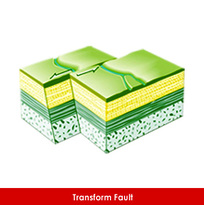Transform Boundary

Transform boundaries are created when two plates slide past each other. There are two names for Transform Boundaries. It is also known as Transform Fault Boundaries. They have the same meaning but they are just different terms. As this occurs it does not tear or crunch it. For example a stream that has been split into two, the two pieces moved in opposite directions. Transform boundaries do not have the different yet fantastic features that convergent and divergent boundary have, although it does mark its spot near valleys where the boundary of groups of rock are. Did you know both of the plates do not get destroyed nor added, that is why Transform boundaries are known as the "conservative plate boundary".
http://www.cotf.edu/ete/modules/msese/earthsysflr/plates4.html
http://www.freewebs.com/morganisrupert/4_1.jpg
http://www.platetectonics.com/book/page_5.asp
http://www.kidsgeo.com/geology-for-kids/0047-transform-boundaries.php
http://www.cotf.edu/ete/modules/msese/earthsysflr/plates4.html
http://www.freewebs.com/morganisrupert/4_1.jpg
http://www.platetectonics.com/book/page_5.asp
http://www.kidsgeo.com/geology-for-kids/0047-transform-boundaries.php
